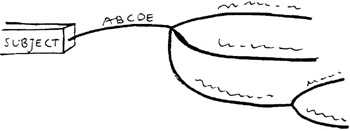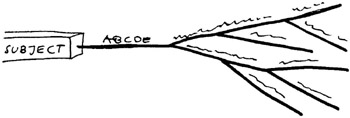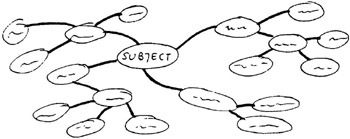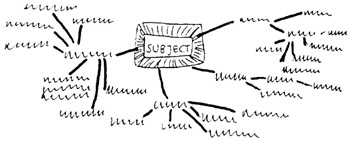style
When you learn a new way of doing things it is common for old habits to be retained and interfere with the new. With learning maps it will show in the number of words you take down and in the way you write the words or draw your mind maps.
With practice you will discover the ways that suit your thinking and how your memory works. Develop your own personal style. If you like to draw pictures and use colour pens a lot, do so! If you remember better with words and with only a few colours added, do so! It is the result that counts !
In this chapter I give you some advice, practical hints and a summary of rules. In the learning map on pages 100 “101 you get a summary of the whole book including the rules.
The style I use personally , which is the way the learning maps have been drawn in this book, is the hayfork model . I draw lines from the central point and when I want to add more words I draw new lines and write the words on them.

Hayfork model
Of course there are other ways of doing it! I will show you some variations here. Try them and find out which one you like most.
The first looks like this. It is called the fishbone model.

Fishbone model
The second looks like molecules or bubbles , so let s call it mubbles (molecular bubbles). It is also called clustering .

Mubble or clustering
(Warning! Don t write a lot of words in the mubble, not more than one word in each.)
The third variety is not one I can recommend but I see it very often in beginners maps. It has no name but looks like this:

There is a risk of confusion if you put too many words in your learning map. If you write the words close to each other it is sometimes difficult to perceive where they come from. Especially if you use your learning maps for giving speeches or if you assemble a lot of information into one learning map, I advise you to avoid this form. It is just as easy to use the hayfork model where you draw lines and write on the lines.
EAN: 2147483647
Pages: 63